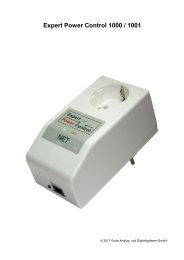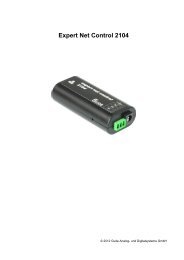Expert mouse CLOCK
Expert mouse CLOCK
Expert mouse CLOCK
Create successful ePaper yourself
Turn your PDF publications into a flip-book with our unique Google optimized e-Paper software.
<strong>Expert</strong><br />
<strong>mouse</strong><strong>CLOCK</strong><br />
DCF77 & HGB<br />
Standard Time Receivers<br />
Time signal<br />
DCF77: The Physikalisch-Technische Bundesanstalt<br />
(PTB) in Braunschweig runs one of the most accurate<br />
caesium atomic clocks of the world. It deviates less than<br />
one second in 300.000 years. The longwave transmitter<br />
with the callsign DCF77 is located at Mainflingen near<br />
Frankfurt and sends time and date signals on a carrier<br />
frequency of 77,5 kHz .<br />
The following modules receive the DCF77 signal:<br />
<strong>Expert</strong> <strong>mouse</strong><strong>CLOCK</strong><br />
<strong>Expert</strong> <strong>mouse</strong><strong>CLOCK</strong> BNC (with BNC plug for an active<br />
antenna)<br />
<strong>Expert</strong> <strong>mouse</strong><strong>CLOCK</strong> extreme (wasserproof up to 5m)<br />
HBG: The Bundesamt für Metrologie und Akkreditierung<br />
Schweiz (METAS) is in charge of the HBG<br />
longwave transmitter in Prangins correspondingly. This<br />
transmitter diffuses at 75 kHz the official time signals<br />
synchronised to Universal Time Coordinated.<br />
The following module receives the HGB signal:<br />
<strong>Expert</strong> <strong>mouse</strong><strong>CLOCK</strong> HGB<br />
Both signals can be received within a distance of about<br />
2000 km around the transmitter’s location.<br />
Radio clocks:<br />
DESCRIPTION<br />
More information on both time signals can be found at the<br />
websites:<br />
www.ptb.de and www.metas.ch<br />
Both DCF77 and HGB signal are received by the<br />
corresponding module and are transmitted to the PC via a<br />
serial or USB port.<br />
Please notice that all modules work only in conjunction<br />
with the PC clock. Besides all modules must keep dry<br />
(except <strong>Expert</strong> <strong>mouse</strong><strong>CLOCK</strong> extreme).<br />
The following comments are valid for all modules!<br />
INSTALLATION OF THE HARDWARE<br />
Usage at a serial port<br />
Connect <strong>Expert</strong> <strong>mouse</strong><strong>CLOCK</strong> to a 9 pin serial port.<br />
With the help of a usual adaptor the module can also be<br />
connected to a 25 pin serial port.<br />
Usage at an USB Port<br />
1. First make sure that your PC is supporting USB devices<br />
and that your USB Hub is installed properly. Perhaps<br />
you have to activate USB Support at BIOS first (more<br />
information on this can be found in the PC manual).<br />
2.Connect <strong>Expert</strong> <strong>mouse</strong><strong>CLOCK</strong> with the USB Adap-<br />
tor.<br />
3.Connect the USB Adaptor to your PC and insert the<br />
driver disk.<br />
4.After Windows has detected the USB device, a new<br />
driver is requested. It can be found in the main directory<br />
of the driver disk (Usb<strong>mouse</strong>.inf).<br />
5.After having installed <strong>Expert</strong> <strong>mouse</strong><strong>CLOCK</strong> USB<br />
successfully, it will be displayed in the device manager.<br />
INSTALLATION OF THE SOFTWARE<br />
Usage under Windows 9x/ME/NT/2000/XP<br />
1.In case of using <strong>Expert</strong> <strong>mouse</strong><strong>CLOCK</strong> at a serial port,<br />
please make sure that the FIFO buffer of the serial port<br />
is deactivated!<br />
2.Insert the driver disk. The setup program should launch<br />
automatically. If not, start SETUP.EXE from the main<br />
directory of the CD manually. Follow the instructions<br />
which will guide you through the installation process.
The Windowssoftware<br />
The enclosed windows software converts the received<br />
MET/MEST signal into UTC and adjusts the PC’s system<br />
time regularly. The local (displayed) time results from the<br />
adjusted system time and the operating systems’s settings<br />
(time zone, daylight saving changings). Detailed information<br />
can be found in the software help menu under<br />
“Timesynchronisation at Windows”.<br />
Software Options<br />
�<br />
�<br />
�<br />
Menu Bitsequence<br />
The received bits (0,1) of the last two minutes are<br />
displayed here. Both rows should ”fill” with bits<br />
completely. The bit’s meaning ist displayed beneath<br />
the rows.<br />
Option Time shift<br />
A constant offset to the received time signal can be set<br />
here. Normally, this option should be deactivated.<br />
Before using this option please read the comments on it<br />
in the software’s help menu.<br />
Option max. offset ...<br />
If this option is enabled the time will be adjusted only if<br />
the difference between received time and current time<br />
is less than 90 minutes. Using this option is only<br />
advisable in case of bad receive. Before using this<br />
option please read the comments on it in the software’s<br />
help menu.<br />
Usage under Linux/Unix<br />
(only for DCF77 models)<br />
<strong>Expert</strong> <strong>mouse</strong><strong>CLOCK</strong> can be used under Linux with the<br />
help of the XNTP package both as serial and USB<br />
version. With NTP it is possible to built up your own NTP<br />
server which retrieves the data from <strong>Expert</strong> <strong>mouse</strong><br />
<strong>CLOCK</strong> and provides the time and date information on<br />
the network. A detailed description of the usage under<br />
Linux can be found at our website www.gude.info.<br />
ALIGNMENT OF THE MODULE<br />
After having installed <strong>Expert</strong> <strong>mouse</strong><strong>CLOCK</strong> the LED<br />
at the module should blink green and flash red once per<br />
second.<br />
If the LED doesn’t shine, please check the connection of<br />
the module. If the LED shines only red, the module is<br />
likely to be placed<br />
too near by a monitor.<br />
Irregular blinking<br />
indicates a bad<br />
receive or a disturbance<br />
of the signal.<br />
Causes could be<br />
monitors (screen<br />
frequency of 77 and<br />
75KHz respectively),<br />
electrical devi-<br />
The signal undulates from the ces, or contact with<br />
transmitter’s location. Therefore the other modules which<br />
receive is best when aligning the<br />
are magnetical or<br />
module as shown in the picture.<br />
contain iron.<br />
In case of disturbances change the screen frequency,<br />
replace disturbing devices or change the position of the<br />
module.<br />
After having found a good postion fix the module with the<br />
enclosed sellotape. After two minutes the PC clock will be<br />
synchronised.<br />
�<br />
�<br />
�<br />
SUPPORT<br />
The windows software contains a detailed help menu.<br />
There you can find more information on <strong>Expert</strong><br />
<strong>mouse</strong><strong>CLOCK</strong> and the various software options as<br />
well as a detailed FAQ list.<br />
Both the latest software and driver are free available at<br />
our website www.gude.info.<br />
If you have further questions, please contact our team .<br />
Eintrachtstraße 113<br />
50668 Köln<br />
Germany<br />
Phone:+49-221-912 90 97<br />
Fax: +49-221-912 90 98<br />
www.gude.info<br />
info@gude.info
















